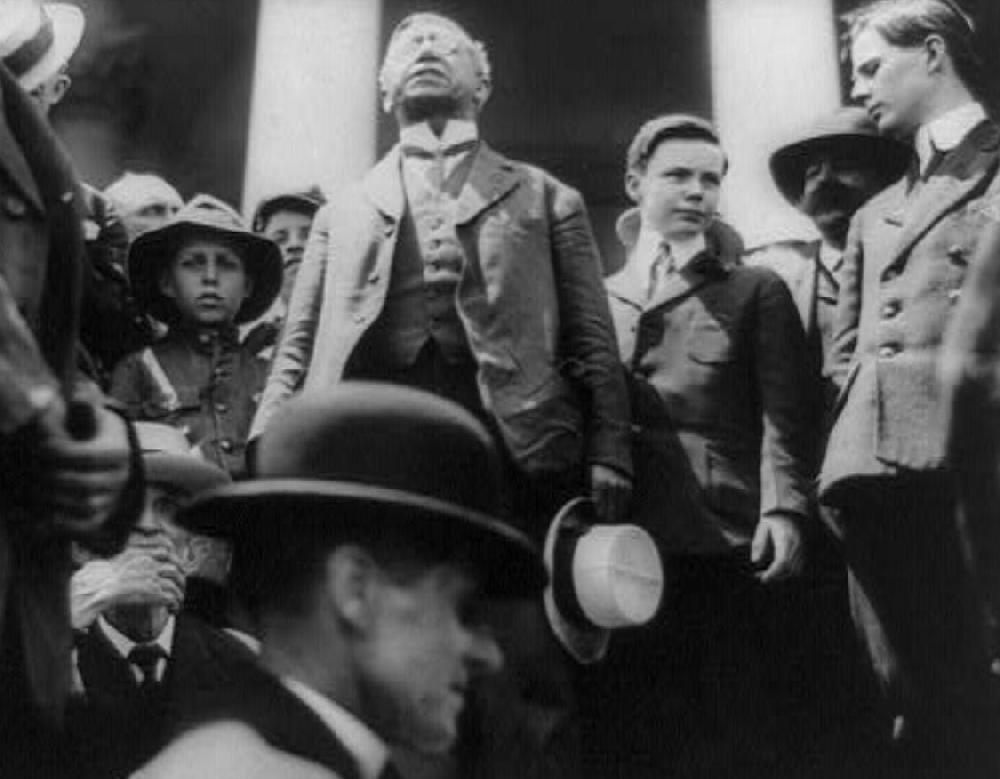
United States Economic History: 19th Century -- Panic of 1893

Figure 1.--Jacob Coxey was a midwestern nbusinessman whose interests were disrupted by the Panic of 1893. Coxey as part of his businesses expeienced terrible roads. Few outside city limits were paved. And he saw many able-bodied workers were unemployed. Coxey proposes a Federal government investment plan to put people to work on roads and other public infrastructure projects. Both Congress and President Cleveland had no interest in it. Coxey organize a protest march of jobless men from his farm near Massillon, Ohio to Washington. Unemployed workers joined the ranks of what became known as Coxey's Army along the way. They were, however, only 500 men when they arrived in Washington (1894). The police arrested Coxey for trespassing on public property. His supporters quietky dispersed after Coxey was arrested. Here he is 20 years later to commemorate the effort (1914). The idea of Federal intervention would grow, with the estanlishment of the Federal Reserve (1913), the World War I effort (1917-18), and finally the Wall Street crash (1929) an resulting Great Depression.
|
|
The Panic of 1893 led to another Depression which affected the economy throughout much of the 1890s. In the final days of the Harrison Administration (1889-93), the Reading Railroad, one of the major eastern railroads, went bankrupt and into receivership. Other railroads which had overbuilt were also having difficultings, but Reading went bankrupt. Becaus of its importance, many banks and businesses involved on the Reading and other railroads had to declare babkruptsy which caused many other concerns to go bankrupt. The stock market fell precipitously. European companies were not as tied to America as was the case in 1929, but America was already a major infustrial power and thus the American panic rippled across the Atlantic. European investors began selling American securities as well. American fell into a serious depression and European economices slumped as well, adversely affecting American export markets. The Panic began in the American Northeastern financial and industrial sectors, but spread to the more agricultital South and West. Several thousand business had to close and some 4 million workers lost their jobs. Earlier in a more agriculturl America, people could survive on the farm and could survive on the family farms of relatives. In the more industrial society of the 1890s, this was less possible. Newly elected Democratic Preident Cleveland did not react the the deepening economic crisis. Both Democrats and Republicans at the time strongly believed that the business cycle was a natural occurrence rather like the weather and politicans should not tamper with it. The result of tampering in 1929 showed that Government interevention if poorly conceived could make the situation worse, but it was beginning to become apparent by 1894 that in an industrial economy that the public was going to demand governmental action and there would be decided shift to the Republican Party after the Cleveland Administration. One development was Coxey's Army (figure 1). Coxey demanded that the Federal government assist unemployed workers by hiring them for infrastructure projects, roads and government buildings. The idea attracyed lottle support (1894), but the idea would greadually gain public suppoty. Democrats and Republicans in Congress and President Grover Cleveland refused. President Cleveland did intervene in one area. The Republican Harrison administration and substantianlly increased Federal spending. The Democratic Congress which authorized the spending became known as the 'Billion Dollar Congress'. The Dependent Pension Act and naval expansion were the major budget busting programs. Cleveland was concerned as a result of the gold drain. The Sherman Silver Purchase Act led to the gold drain. The United States gold reserves fell below $100 million level. This was a psychological barrier whhich disturbed the financial community and weakened public trust in papr currency. President Cleveland acted to support the gold standard. He ordered the Treasury to issue bonds to purchase gold. This divided the Democratic Party and alienated the silver forces of the South and West which had been supporting the Democrats. It would lead to William Jeanings Bryan winning the 1896 Democratic nomination and his 'Cross of gold' speech (1896). James Stillman who ran City Bank easily rode out the crisis, largely because he had amassed substantial gold holdings. Stillman and J.P. Morgan helped bail out the virtually babkrup Federal Government (1895). America ended the 19th century with a very sophisticated, industrial economy, but still without a central bank. The Panic of 1893 and the resulting Depression had a lasting impact on the economy. The economy did not recover from the Depression of the 1890s until early-1897 and the advent of the Republican McKinnely Administration. Not that the Republicans disagreed with Cleveland, but the general public reaction to an economic downturn is to throw out the incumbents and vote in the other party. McKinely did not initiate new policies, but in the public mind was credited for the upswing. One significant response to the business failures was an numerous business consolidations. Many workers and the less affluent believed that their plight had been ignored and they were left at the mercy of events. Many blamed the expanding trusts and the Sherman Anti-Trust Act (1890) was not suffucent. Many believed that new leadership was needed as the new century approached. Begiining with the 1896 Campaign, the Republicans would control the White House for three decades (except when former President T. Roosevelt split the Reoublican Party alowing Democrat Wooddrow Wilson to be elected).
CIH

Navigate the Children in History Website:
[Return to the Main U.S. 19th century Economic Crisis page]
[Return to the Main U.S. Economic Crisis page]
[Return to the Main U.S. Economics page]
[Return to the Main Economics page]
[Introduction]
[Animals]
[Biographies]
[Chronology]
[Climatology]
[Clothing]
[Disease and Health]
[Economics]
[Ethnicity]
[Geography]
[History]
[Human Nature]
[Law]
[Nationalism]
[Presidents]
[Religion]
[Royalty]
[Science]
[Social Class]
[Bibliographies]
[Contributions]
[FAQs]
[Glossaries]
[Images]
[Links]
[Registration][Tools]
[Children in History Home]
Created: 5:49 PM 10/12/2017
Last updated: 5:49 PM 10/12/2017



